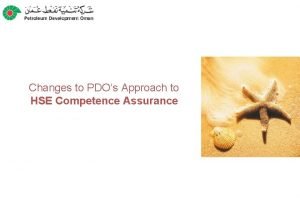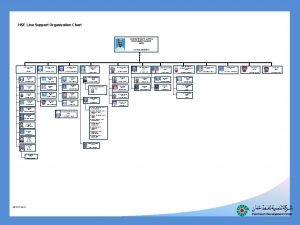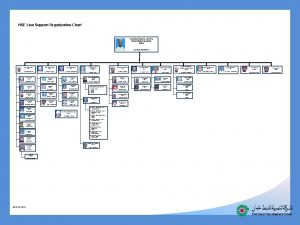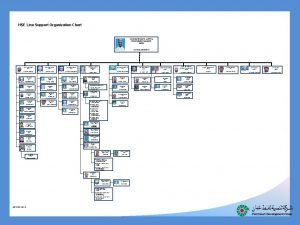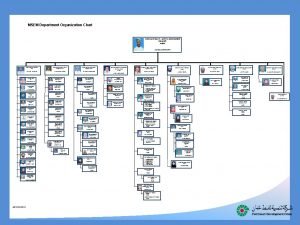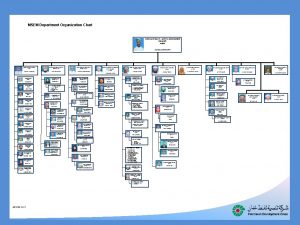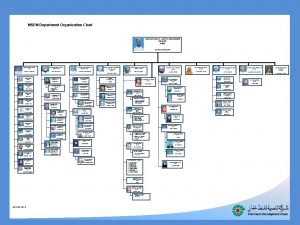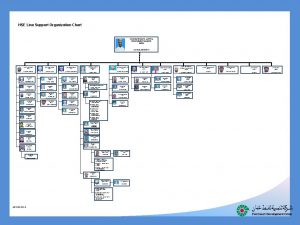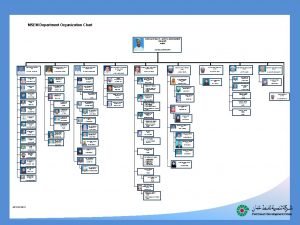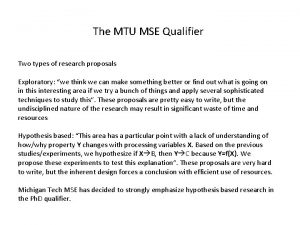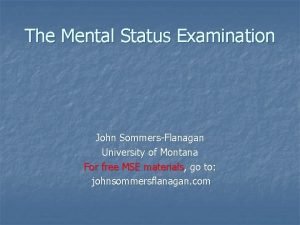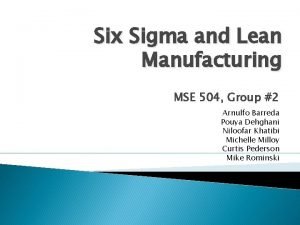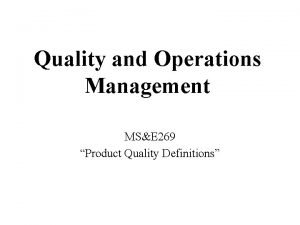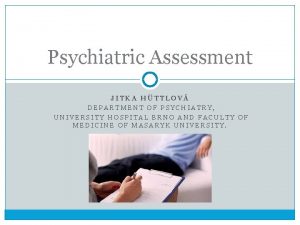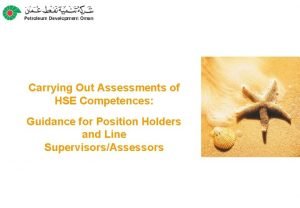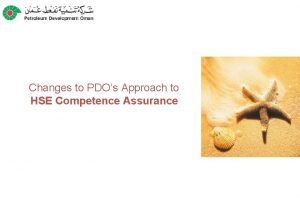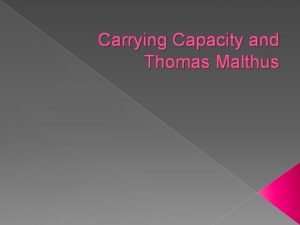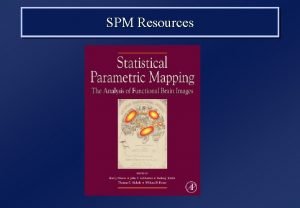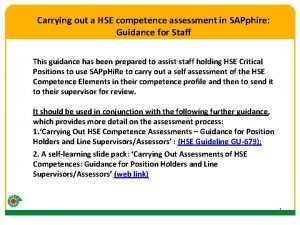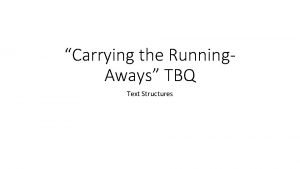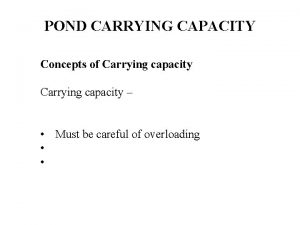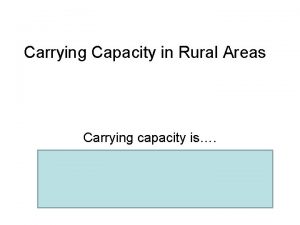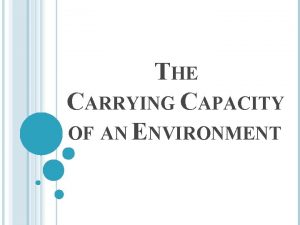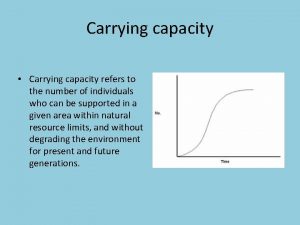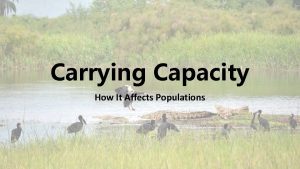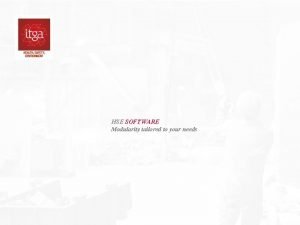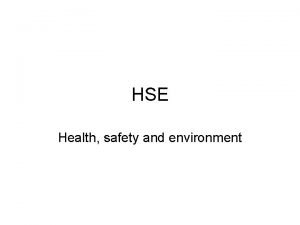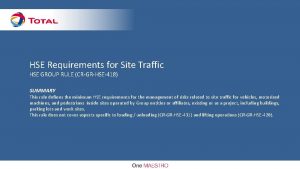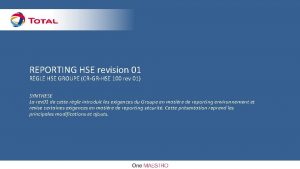MSE department HSE Critical SPM session Carrying Out




























- Slides: 28

MSE department - HSE Critical SPM session Carrying Out Assessments of HSE Competences: Guidance for Position Holders and Line Supervisors/Assessors

Purpose • This slide pack is designed to be a self-learning module to assist with the assessment of the HSE competences of people holding HSE Leadership or HSE Critical Positions Responsible for Planning/Supervisory HSE Critical Activities; • It is designed for use by position holders and line supervisors (or authorised assessors, where used) of such positions; • It is not intended to provide detailed guidance on how to use the Competence module of SAPp. Hi. Re, for which other guidance exists (see next slide).

Where to Get Further Help • If further advice and/or guidance is required on assessment issues, you should contact your Skill Pool Manager in the first instance or the HSE Skill Pool Manager; • If you require further guidance on SAPp. Hi. Re issues, you should contact the SAP help desk on 1111.

HSE Competence Assessment/Development Process: Responsibility Overview Competence Assessment Process

Using an ‘Authorised Assessor’ • If a line supervisor is not confident of his/her capability to carry out all or part of an assessment of HSE competence, he/she can request the input of a ‘authorised assessor’; • The HSE Skill Pool Manager keeps a list of HSE ‘authorised assessors’; • However, if an assessor is to be used, or possibly used, the name of the assessor should be entered into SAPp. Hi. Re by the position holder and this has to be done before the self-assessment is submitted for review (see detailed SAPp. Hi. Re guidance).

Assessment: The Six Steps 1. Competence requirement reviewed and agreed 2. Individual completes a self assessment in SAPp. Hi. Re 3. Self assessment reviewed by line supervisor 4. Assessment discussion between individual and line supervisor: decisions and feedback 5. Actions agreed to mitigate any gaps identified 6. Assessment outcome and actions recorded in SAPp. Hi. Re

1. Competence requirement reviewed and agreed Guidance for Position Holders & Line Supervisors • Competence requirements for each of the 3 HSE competence elements (HSE Lead, HSE Prepare & HSE Apply) should already have been included in the overall competence requirements for the position in SAPp. Hi. Re; • To view the competence requirements for the position you need to use the ‘Print’ facility in SAPp. Hi. Re to download and print off a file version of the competences (see detailed SAPp. Hi. Re guidance); • The details of the Proof Points for each HSE competence element can be found in Procedure HSE-1980. They can also be accessed via the following web link: Web Link

1. Competence requirement reviewed and agreed Guidance for Position Holders & Line Supervisors • The individual and line supervisor should check that the requirements make sense in relation to the HSE risk management demands of the position; • If no requirements are shown in SAPp. Hi. Re or if the requirements seem wrong, contact your Skill Pool Manager or the HSE Skill Pool Manager; • The supervisor should decide whether he will carry out the assessment or will need the input of an authorised assessor; • If an assessor is to be used, or possibly used, the name of the assessor should be entered into SAPp. Hi. Re by the position holder and this has to be done before the self-assessment is submitted for review (see detailed SAPp. Hi. Re guidance)

2. Individual completes a self assessment in SAPp. Hi. Re Guidance for Position Holders • You should assess you current competence against the requirements for your position (Awareness, Knowledge or Skill) for each of the 3 HSE competence elements (HSE Lead, HSE prepare and HSE Apply); • You should do this by assessing yourself against the detailed Proof Points for that level of competence (see next slide for examples of the Proof Points); • The details of the Proof Points for each HSE competence element can be found in Procedure HSE-1980. They can also be accessed via the following web link: Web Link

2. Individual completes a self assessment in SAPp. Hi. Re Examples of HSE Competence Proof Points HSSE Lead: Awareness Level Can describe in basic terms: • Why good HSE management is good for business performance. • PDO’s HSE Commitment, Golden Rules and Life Saving Rules and how non-compliance is managed. • What personal attitudes and behaviours are important for achieving high HSE performance. • What they personally do to be a good HSE example to others and to promote achievement of HSE goals in their own part of the business. • The main HSE issues of their own part of the business and what is being done to resolve them. • The HSE objectives of their own part of the business and what is being done to meet them. • What inspection and audit processes are applied to HSE. HSSE Apply: Skill Level Can provide examples of having taken a leading role in: • Ensuring HSE-MS requirements and identified risk control measures are effectively implemented within own organisation. • Ensuring necessary processes and procedures are in place to provide Safe Systems of Work for activity under own responsibility. • Reviewing and evaluating work plans and procedures to address worksite HSE hazards and improve risk management using the hierarchy of controls. • Managing organizational or operational changes; assessing and mitigating their potential effects on HSE risks and controls. • Conducting periodic site safety inspections or audits to monitor the effectiveness of the controls in operation and instituting changes to maintain a Safe System of Work. • Evaluating HSE performance data for staff and contractors to identify underlying trends and implement corrective action plans. • Carrying out incident investigations in line with PDO requirements, reviewing findings and ensuring close out of actions. • Managing and directing others during emergency response [real or exercise].

2. Individual completes a self assessment in SAPp. Hi. Re Guidance for Position Holders • If you believe you meet all the Proof Points for the required level of competence, you should click the radar button for that level of competence and enter evidence to support your self-assessment; • Relevant and recent evidence should be recorded in the evidence text section in SAPp. Hi. Re to support the self-assessment; • The range and depth of evidence to be recorded depends on the competence level concerned (see following slides); • Evidence can be included in SAPp. Hi. Re in the form of attached documents (see detailed SAPp. Hi. Re guidance)

2. Individual completes a self assessment in SAPp. Hi. Re Evidence Expectations Evidence Required For Awareness: The position holder needs only to state the key positions where the understanding required by the Proof Points has been gained, together with any relevant training, which may have been attended. The Line Supervisor or may wish to test the level of understanding claimed via some specific questions at the meeting arranged to review the self-assessment. Evidence Required For Knowledge: Slightly more detailed evidence is required of relevant training completed plus examples of where the practical experience required by the Proof Points has been gained. If the Line Supervisor does not have sufficient personal experience of the position holders work and does not have sufficient practical, observed evidence to cover all the Proof Points, he/she should explore the level of competence via questions at the meeting arranged to review the self-assessment. Evidence Required For Skill, the position holder should provide specific written examples of when and where he/she took a leading role in carrying out the actions required by the Proof Points. The Line Supervisor (or Assessor, if used), should satisfy himself/herself that the individual has effectively carried out all the actions required to a satisfactory standard.

2. Individual completes a self assessment in SAPp. Hi. Re Evidence should meet the four CARS criteria Current - the evidence is sufficiently recent to support a conclusion that the Proficiency Level of Competence is still valid; Authentic - the evidence reflects the position holder’s own work; Relevant - the evidence is appropriate for the position and the Competence Element being assessed; Sufficient - the evidence adequately covers all the relevant Proof Points of the Competence Element at the Proficiency Level being assessed.

2. Individual completes a self assessment in SAPp. Hi. Re Guidance for Position Holders • If you believe you do not meet all the Proof Points for the required level of competence, you should list in the evidence box, those Proof Points which you believe you do not meet; • You should then click the radar button for the level of competence in SAPp. Hi. Re for which you believe you meet all the requirements and enter evidence to support your self-assessment; • If you believe you meet all the Proof Points for a higher level of competence than that required for your position, you should click the radar button in SAPp. Hi. Re for the level of competence at which you assess yourself and enter evidence to support your selfassessment; • Once you are happy with your self-assessment, you should submit it to your line supervisor using the ‘Send Assessment’ function.

3. Self assessment reviewed by line supervisor Guidance for Line Supervisors • You should open the self-assessment (see detailed SAPp. Hi. Re guidance). • If you do not feel competent enough to do the assessment, you should invite help from the authorised assessor identified and named in SAPp. Hi. Re as part of Step 1; • You should do this via the ‘Send Assessment’ function in SAPp. Hi. Re (see detailed SAPp. Hi. Re guidance).

3. Self assessment reviewed by line supervisor Guidance for Line Supervisors/Assessors • You should review the evidence provided in the self-assessment and consider whether it meets the CARS criteria (see slide 14) and fully supports the competence levels self-assessed; • You should consider and access other sources of evidence (see next slide); • In making your assessment, you should consider whether the individual satisfies all the required Proof Points specified for the competence and the proficiency level concerned (see slide 11 for examples of Proof Points) • The details of the Proof Points for each HSE competence element can be found in Procedure HSE-1980. They can also be accessed via the following web link: Web Link

3. Self assessment reviewed by line supervisor Guidance for Line Supervisors/Assessors • Personal Observation provides the most natural form of evidence; it is valid, and reliable; • However, access to first hand evidence of an individual’s performance may not always be possible; • So, what other sources of evidence can be used ? – Individual’s self assessment statements – Work History (CV) • Other options for additional evidence (if considered necessary) – Statements from others who have worked with the individual being assessed – Records, Documents, Products of Work

3. Self assessment reviewed by line supervisor Guidance for Line Supervisors/Assessors • For each competence element, you should consider the evidence provided and your own experience of the individual to make an initial conclusion whether: – The evidence seems to support the self assessment but you may need to check some facts; – The evidence you have is not sufficient to make even an initial conclusion. • For each competence element, decide what you want to find out from the discussion with position holder; • When you have reviewed the self-assessment, you should arrange a faceto-face discussion with the position holder; the review should NOT be done by email and you should NOT simply make your decision without engaging with the position holder.

4. Assessment discussion between individual and line supervisor: decisions and feedback Guidance for Line Supervisors/Assessors • The discussion provides an opportunity for the supervisor/assessor to: – – Explore areas of uncertainty; Secure or clarify evidence; Come to conclusions about the level of competence in each element; Discuss and agree any gaps and actions to address them • It is recommended that you review each competence element in turn; • It can be helpful to review what the competence element entails and the proof points at A, K or S level; • Give feedback on your preliminary conclusion, after the discussion of each competence element: – Competence level assessed; any gap you believe exists; recommended actions to fill the gap; – if you are uncertain, say so and what you plan to do to reach a conclusion (e. g. request further evidence)

4. Assessment discussion between individual and line supervisor: decisions and feedback Guidance for Line Supervisors/Assessors • The assessment process requires a particular proficiency level (A, K or S) to be decided; • However, the reality is often that the level is somewhere in between; • For example, someone may meet all the K level requirements and some of the S level requirements, but not all the ones relevant for the position; • The result is that he/she must be assessed at Knowledge; • It is most important to define and explain what the missing requirements of the competence are and to recommend actions to address the gaps(s).

4. Assessment discussion between individual and line supervisor: decisions and feedback Guidance for Line Supervisors/Assessors • Usually, you should not identify a gap without making a recommendation on how to close it; • Situations may arise, where the individual does not meet a particular Proof Point requirement, but it is difficult to define the action to be taken in the present position to fill the gap; • This may be because that particular Proof Point requirement is not relevant to the present position; usually, this arises in the case of Skill requirements; • If you cannot define what the person needs to do in his/her current position to demonstrate Skill, then the position may not need that particular Proof Point requirement; • If you are fully confident that the Proof Point is not relevant and not required for the position, then you should: – Assess the competence at Skill; – Note in SAPp. Hi. Re that the gap exists, but it is not considered relevant for the position. • If in doubt, consult an authorised HSE competence assessor (contact the HSE Skill Pool Manager).

4. Assessment discussion between individual and line supervisor: decisions and feedback Guidance for Line Supervisors/Assessors • Make detailed notes as you go along • Note down key, additional evidence or clarification acquired during the assessment discussion; • Note down the conclusion in terms of level assessed (A, K, S); • Note down what gap(s) you identified against the required criteria; • Note down what feedback you provided and agreed in terms of relevant action to address the gap(s); • After the assessment your comments, conclusions and recommendations will need to be entered into SAPp. Hi. Re

5. Actions agreed to mitigate any gaps identified Guidance for Line Supervisors/Assessors • Importantly, the discussion should be used to define and discuss any gaps versus the position requirement that the assessment has identified and what actions should be taken to address those gaps; • The appropriate actions should include ones designed to both: – Fill gaps; – Mitigate the possible risks associated with gaps s

5. Actions agreed to mitigate any gaps identified Potentially Relevant Gap Filling Actions 1. Awareness/Knowledge Level Gaps • Formal training • Self Learning (SOU) • Reading Documents • Participating in activities 2. Skill Level Gaps • Cannot be filled by training alone; • Questions that need to be considered: – What hasn’t yet been proven ? –How can this be done on the job ? –What actions need to be taken ? –What needs to be delivered to prove that the gap is filled ?

5. Actions agreed to mitigate any gaps identified Guidance for Line Supervisors/Assessors • The approach to risk mitigation will potentially involve : – Reallocating the activity to someone who is fully competent; – Providing enhanced supervision and/or support; • You should record, either in SAPp. Hi. Re or elsewhere, the actions identified to mitigate the potential risks, including any restrictions on the tasks that individuals are permitted to perform; • Competence development actions should be agreed and documented in the annual Performance and Development Review documentation; • You should ensure that the position holder understands and agrees with any actions including any temporary constraints on activity and/or decision making.

6. Assessment outcome and actions recorded in SAPp. Hi. Re Guidance for Assessors • You should record your comments, conclusions and recommendations in SAPp. Hi. Re, including the basis for those conclusions and any recommended/agreed actions; • You cannot change the assessed competence level in SAPp. Hi. Re – this can be done only by the line supervisor; • However, you can record a recommend change to the line supervisor in the ‘Comments’ sections in SAPp. Hi. Re; • If any issues emerge from the assessment, you should arrange to discuss them with the line supervisor; • You should then return the assessment to the line supervisor via the ‘Send Assessment’ function (see detailed SAPp. Hi. Re guidance).

6. Assessment outcome and actions recorded in SAPp. Hi. Re Guidance for Line Supervisors • The final assessment conclusions and any actions should be recorded in SAPp. Hi. Re, including appropriate evidence/comments to support the conclusion; • If the assessment has been carried out by an assessor, you should review their conclusions/recommendations and discuss them with them, as necessary, to ensure that you understand agree them and endorse any recommended actions; • If an assessor has been used, you should arrange a meeting with the position holder to review the assessor’s conclusions and to review actions to address any identified gaps;

6. Assessment outcome and actions recorded in SAPp. Hi. Re Guidance for Line Supervisors • If the outcome of the assessment requires a change to the competence level assessed by the position holder, the ‘radar button’ in SAPp. Hi. Re should be changed to show the finally assessed level of competence; • Once you are confident that all relevant information has been recorded in SAPp. Hi. Re and that the radar buttons for each competence element show the finally assessed competence levels, you can then finalise the assessment using the ‘Complete’ function; this can be done only by the line supervisor; • Until this has been done, the assessment will be reported as not yet having been fully completed.
 Critical semi critical and non critical instruments
Critical semi critical and non critical instruments Semi critical
Semi critical Hse critical activities
Hse critical activities One direction figurative language
One direction figurative language Hse organization chart
Hse organization chart Organization chart hse department
Organization chart hse department Hse department organization chart
Hse department organization chart Hse advisor adalah
Hse advisor adalah Tdgxlbnnob4 -site:youtube.com
Tdgxlbnnob4 -site:youtube.com Mse org chart
Mse org chart Hse department organization chart
Hse department organization chart Hse chart
Hse chart Safety department organization chart
Safety department organization chart Carrying out research
Carrying out research Carrying out an investigation
Carrying out an investigation Slidetodoc.com
Slidetodoc.com Postech mse
Postech mse Mtu mse
Mtu mse Loose thought process
Loose thought process Poor insight and judgement examples
Poor insight and judgement examples Serial 7s or 3s
Serial 7s or 3s Mse six sigma
Mse six sigma Cwqc ishikawa
Cwqc ishikawa Psychiatric assessment
Psychiatric assessment Postech mse
Postech mse Mse iitk
Mse iitk Dataset multiple linear regression
Dataset multiple linear regression Cis 515 upenn
Cis 515 upenn Postech mse
Postech mse


